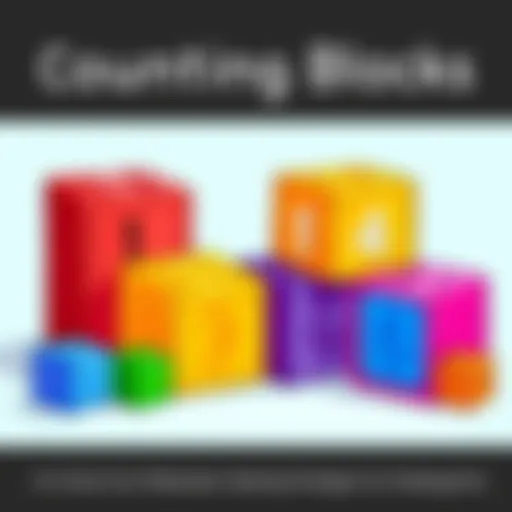Mastering Algebra: A Beginner's Guide to Concepts


Intro
Algebra, that enigmatic branch of mathematics, often sparks curiosity tinged with a little fear, especially for beginners. Whether you’re a parent, caregiver, or young enthusiast, the road to grasping algebraic principles can feel like deciphering a coded map. This guide aims to simplify that journey by breaking down essential concepts into digestible portions.
Basic elements such as variables, equations, and functions may seem daunting at first glance, but they are the very building blocks of algebra. Mastering them can open a treasure chest of problem-solving skills and analytical thinking, beneficial not just in math but across various subjects. With the right tools and strategies, algebra can become less of a stumbling block and more of a stepping stone toward greater mathematical prowess.
Let’s delve into interactive and engaging ways to learn algebra, ensuring that you feel equipped and confident along the way.
Creative Activities
Engaging hands-on activities can make the world of algebra more tangible and fun for young learners. Here are some creative craft ideas and step-by-step guides designed to weave algebra into enjoyable experiences.
Craft Ideas
- Algebraic Art: Create colorful graphs using painter's tape to delineate axes on a canvas or cardboard. Students can use stickers or colored papers to represent various data points and see how their equations come alive visually.
- Equation Scavenger Hunt: Design a scavenger hunt wherein students search for items in their house that represent algebraic concepts, like a book for "b" or a box for "x". This will not only make learning interactive but also relatable.
Step-by-Step Guides
- For Algebraic Art:
- For the Scavenger Hunt:
- Gather materials: painter's tape, canvas, stickers, or papers.
- Tape your axes on a canvas to set the stage for your graph.
- Choose your equations and display them creatively using materials at hand.
- Create a list of algebraic terms to find.
- Set a timer and let kids hunt for the items, taking photos as they go.
- Discuss the significance of each item once everyone is back.
Educational Value
These activities not only stimulate creativity but also foster understanding by bridging abstract math concepts with real-world shapes and items. They encourage children to think critically while making learning memorable.
Fun Quizzes
Once the basics of algebra are introduced, it’s essential to reinforce learning through quizzes. Quizzes provide a fun and competitive way to assess understanding and retention.
Quiz Topics
- Variables and expressions
- Solving simple equations
- Graphing linear equations
- Real-life application of algebraic concepts
Question Types
Questions can range from multiple-choice to fill-in-the-blank, and true or false statements, effectively engaging the learners in various ways:
- Multiple-choice: "What is the value of x in the equation x + 5 = 12?"
- Fill-in-the-blank: "An algebraic expression is made up of terms such as ____."
- True/False: "Every equation has a solution."
Knowledge Reinforcement
Participating in quizzes helps crystalize the knowledge gained while learning algebra. They provide immediate feedback and can spotlight concepts that may need further review, ensuring that no child gets left behind.
Fact-Based Articles
Delving deeper, fact-based articles provide a well-rounded exploration of algebra and its applications. These articles can make complex ideas more digestible and relatable.
Topics
Covering subjects like:
- The history of algebra
- Famous mathematicians and their contributions
- The relevance of algebra in today’s world
Engaging Content
These articles should present facts in an easy-to-understand manner, using analogies and examples that resonate with kids and adults alike. For instance, explaining variables as “mystery boxes” that hold different values depending on the situation can be incredibly engaging.
Preface to Algebra
Algebra forms the backbone of mathematics, acting as a bridge to understanding a multitude of mathematical concepts. By exploring the core principles of algebra, individuals can build a solid foundation for their future mathematical endeavors. This section serves to unravel the essence of algebra, laying the groundwork for those eager to learn and apply its principles in real life.
Defining Algebra
Algebra is essentially a branch of mathematics that deals with symbols and the rules for manipulating those symbols. Much like how a recipe uses certain ingredients to create a dish, algebra uses letters or symbols to represent numbers in equations. These variables allow you to express relationships between different quantities in a concise manner. For instance, in the expression 2x + 3 = 7, the letter 'x' is a variable representing an unknown quantity. Understanding these basics is crucial because it opens up avenues for solving problems where not all values are known.
Algebra can be seen as the language of mathematics; it offers tools to express complex ideas simply. It provides a means to not only represent numbers but also to manipulate them, enabling us to unravel mysteries hidden in numerical puzzles.
Importance of Algebra in Everyday Life
The relevance of algebra stretches far beyond textbooks and classrooms. Here are some reasons why understanding algebra is vital in our daily lives:
- Budgeting and Finance: Whether you're planning your monthly expenses or figuring out interest rates on loans, algebra comes into play. You often need to set up and solve equations to manage your funds effectively.
- Cooking and Baking: Recipes can require adjustments depending on the number of servings, and understanding proportions and ratios often involves algebra.
- Sports: Analyzing player statistics and team performance often relies on algebraic expressions to derive meaningful conclusions.
"Understanding algebra is not just an academic exercise; it's a crucial skill that empowers you to tackle real-world challenges."
In summary, algebra is more than an abstract concept; it's a practical skill set that enriches our decision-making capabilities in everyday life. By grasping these initial ideas, learners position themselves for greater success as they delve deeper into more advanced topics.
Fundamental Concepts


Understanding the fundamental concepts of algebra is like laying the cornerstone of a stout building. If these foundational elements are not well grasped, the entire structure of mathematical understanding can waver over time. Algebra is more than just a series of equations and symbols; it's a way of thinking. It's about finding patterns, making connections, and solving problems that, at first glance, may seem daunting. By delving into the core principles—variables, constants, expressions, equations, and the order of operations—learners not only equip themselves with necessary skills for advanced mathematical topics but also enhance their logical reasoning and analytical abilities.
Variables and Constants
At the heart of algebra lie variables and constants. Variables are symbols, commonly denoted by letters like x, y, or z, representing unknown values. On the flip side, constants are fixed numbers, such as 4 or -3. Think of a variable as a mystery box; you don’t know what's inside until you solve the equation. For example, in the expression 3x + 5, x is the variable, and while we don’t know its value just yet, we understand that multiplying it by 3 and then adding 5 gives us a range of potential results based on what x could represent.
"A variable can take on various values, while a constant remains the same. This concept is pivotal in forming equations."
Expressions and Equations
Once individuals grasp variables and constants, they move on to understanding expressions and equations. Expressions are combinations of numbers, variables, and operations, like addition or multiplication, without an equality sign. For instance, 2y + 3 is an expression. Equations, however, introduce balance and equality into the mix. When you see 2y + 3 = 7, you're tasked with finding a value for y that satisfies the equation. This idea of equality is critical in algebra, as it sets the stage for problem-solving and reasoning.
Order of Operations
When tackling algebra, knowing how to prioritize operations can save a world of headache. The order of operations, often recalled with the acronym PEMDAS (Parentheses, Exponents, Multiplication and Division, Addition and Subtraction), is essential. This sequence dictates how to approach expressions, ensuring calculations are performed correctly. If someone tackles 2 + 3 × 5 without following the order, they might hastily conclude 25, when the accurate answer is 17. Remembering this order is not merely a guideline; it’s more like a rule of thumb that leads to correct outcomes.
It’s worth noting that in some cultures, BIDMAS or BODMAS is used instead of PEMDAS, but the core principles remain unchanged.
As we venture forward into more advanced topics in algebra, these fundamental concepts serve as the bedrock upon which all additional knowledge will be built. Mastering these elements will empower students, enabling them to tackle tougher challenges with greater confidence, and leading them on a rewarding journey through the world of mathematics.
Key Operations in Algebra
Understanding key operations in algebra is like learning to ride a bike; once you get the hang of it, you can go anywhere! These operations form the backbone of algebraic manipulation, crucial for solving equations and working with algebraic expressions. To a novice, these may seem daunting, yet they hold the power to simplify complex problems and enhance logical thinking. Mastering these operations lays the groundwork for future mathematical success, stimulating both confidence and creativity.
Addition and Subtraction of Algebraic Expressions
Addition and subtraction are the bread and butter of algebraic expressions. They help in combining like terms, which is essential for simplifying problems. For instance, when you see something like 3x + 2x, it’s as simple as putting those like terms together to get 5x. This clean-up process makes it easier to tackle more complex equations later on.
To grasp this concept, let’s break it down:
- Identifying Like Terms: Like terms are terms that have the same variable raised to the same power. For example, 4xy and 7xy are like terms, while 4x and 4y are not. This identification step is crucial in knowing what you can add or subtract.
- Combining the Terms: Once you’ve spotted your like terms, just sum or subtract their coefficients. So, 4xy + 3xy equals 7xy. It’s quick, and this method keeps your calculations tidy.
- Coefficient Influence: Keep an eye on those coefficients. Their values affect the overall expression, so it’s vital to get them right.
"Understanding how to operate with these expressions can drastically simplify your algebra journey."
Multiplication and Division of Algebraic Expressions
Once you’ve mastered addition and subtraction, multiplication and division take your skills to the next level. These operations allow for more advanced manipulation of expressions, crucial in finding solutions to equations.
To dive into this further:
- Multiplication: When multiplying algebraic expressions, the distributive property is your best friend. For instance, when you multiply 3x(2y + 4), you distribute the 3x to both terms in the parentheses, resulting in 6xy + 12x. This simplifies complex expressions and allows for easier calculations.
- Division: On the flip side, dividing algebraic expressions can seem tricky at first glance. However, once you learn to factor and reduce, it becomes manageable. Take the expression 6x² / 3x. Here, you divide the coefficients (6/3), which gives you 2, and then simplify x² / x to x. Thus, the resultant expression is 2x.
Understanding these operations leads to a clearer path in solving equations. It enhances your ability to manipulate various algebraic forms and prepares you for advanced topics like polynomials and functions. When you break it down, each operation has its own little methods and tricks, which makes learning more engaging and less intimidating.
Solving Algebraic Equations
Grasping the concept of solving algebraic equations is especially important in the journey of understanding algebra. It stands out as a pivotal skill that opens doorways to various advanced topics and practical applications. Think of it as the key that unlocks numerous mathematical mysteries. For students, mastering this skill provides not only the ability to find answers but also a deeper comprehension of how numbers and variables interact in the world around them.
The benefits from learning to solve algebraic equations are many. When one learns this topic, it cultivates critical thinking and problem-solving abilities. These skills are not just vital in math classes but extend into everyday situations — like figuring out expenses when budgeting or determining dimensions when crafting. Additionally, a firm grasp of algebraic equations paves the way for higher-level mathematics, such as calculus and statistics. It's like building a sturdy foundation before constructing a tall skyscraper; without solid ground, everything is more likely to come crashing down.
Understanding Linear Equations
Linear equations are among the simplest forms of algebraic equations and form the bedrock of algebraic concepts. A linear equation has a degree of one, means it can be expressed in the form of ax + b = c, where 'a', 'b', and 'c' are constants, and 'x' is the variable. The beauty of linear equations lies in their straightforwardness. They essentially represent a straight line when plotted on a graph, which can be a helpful visual for young learners.
It's crucial to recognize that these equations are more than mere expressions of numbers and letters. They embody relationships between quantities, giving insight into trends and predictions. For instance, if you know your speed and time, the equation can help predict distance traveled. Here's where it gets interesting:
"Every linear equation tells a story, connecting dots in a numeric landscape."
Techniques for Solving Linear Equations
Solving linear equations can seem daunting at first, but a handful of techniques can make this task simpler and more manageable. Here are some common approaches:
- Isolate the variable: This method involves getting the variable (like 'x') by itself on one side of the equation. This could simply mean moving constants across the equals sign while changing signs (like a game where everything must be balanced).
- Combine like terms: When faced with an equation containing similar variables or constants, combine them to simplify the problem. Think of it as tidying up a cluttered room.
- Use inverse operations: Understanding how different mathematical operations relate to each other can offer shortcuts in solving equations. For instance, if you see addition, you can apply subtraction as its inverse to unravel the equation.
An example is beneficial here. Let's say we have the equation:
Following the steps:
- Subtract 3 from both sides:
- Next, divide by 2:
Thus, solving linear equations becomes a delightful puzzle that challenges the brain while also laying the groundwork for future mathematical explorations.
Advanced Topics in Algebra
Understanding advanced topics in algebra is crucial for any learner aiming to progress beyond the basics. While grasping fundamental concepts provides a strong foundation, diving into advanced subjects like quadratic equations often opens the door to more complex problem-solving methodologies. Not only does it enrich logically structured thinking, but it also enables students to apply mathematical concepts to real-life situations. This segment emphasizes the significance of quadratic equations, which can seem daunting but are incredibly practical in various fields, including physics, finance, and engineering.
Preface to Quadratic Equations


Quadratic equations take the form of ax² + bx + c = 0, where a, b, and c are constants and x represents the variable. It might sound complicated at first, but breaking it down reveals a simple structure. Their distinctive characteristic is that they graph as a parabola, which is the U-shaped curve.
The importance of quadratic equations lies in their strong presence in real-world applications. For example, when calculating the trajectory of a ball thrown in the air or analyzing profit maximization in business, quadratic equations become essential tools. Understanding these equations not only increases a student's confidence in algebra but also showcases how mathematics is intertwined with everyday life.
Factoring Quadratic Equations
Factoring a quadratic equation involves breaking it down into simpler expressions that, when multiplied together, give the original equation. This process is vital for solving quadratics because it can often simplify the problem significantly.
To factor a quadratic equation like x² + 5x + 6, one might look for two numbers that multiply to 6 (the constant term) and add up to 5 (the coefficient of the linear term). In this case, 2 and 3 work perfectly. Thus, the factored form is (x + 2)(x + 3) = 0. From here, one can easily determine the values of x that satisfy the equation.
Learning to factor quadratic equations sharpens problem-solving skills and emphasizes the importance of understanding numbers and their relationships. Here are a few key points to recall about factoring:
- Look for common factors first.
- Use techniques like grouping or the reverse FOIL method when necessary.
- Practice makes perfect! The more you factor, the easier it gets.
Using the Quadratic Formula
When factoring proves challenging, the quadratic formula shines as a lifesaver. The formula, x = (-b ± √(b² - 4ac)) / (2a), allows you to find the roots of any quadratic equation, provided that you know the values of a, b, and c. The term under the square root, known as the discriminant, determines the nature of the roots. If it's a positive number, expect two distinct real solutions; if zero, one repeated solution; and if negative, no real solutions—just complex ones.
Using the formula is direct and effective, making it a go-to option for many students. Here’s how it works with an example:
Given the equation 2x² + 4x - 6 = 0, identify a = 2, b = 4, and c = -6. Plugging these values into the formula yields:
This will eventually lead to the roots of the equation.
In summary, mastering quadratic equations, factoring techniques, and the quadratic formula enables students to tackle complex algebraic problems with greater ease. As these concepts cement their role in algebra, learners continue to build a bridge toward advanced mathematics and its practical application.
Quadratic equations are not just numbers on a page; they are keys unlocking the mysteries of the universe's patterns and relationships.
As students move forward in their algebra journey, engaging with these advanced topics will undoubtedly enhance their confidence and skills, preparing them for future mathematical challenges.
Graphing in Algebra
Graphing is a cornerstone of learning algebra, allowing students to visualize equations and understand their relationships more deeply. By translating algebraic expressions into graphical forms, learners can see how changes in variables impact outcomes. This visual representation not only aids comprehension but also enhances problem-solving skills, making algebra more accessible and engaging. Additionally, understanding graphing lays the groundwork for future topics in mathematics, including calculus and statistics.
Understanding Cartesian Coordinates
At the heart of graphing lies the Cartesian coordinate system, a two-dimensional grid system that combines horizontal and vertical axes. The horizontal axis is known as the x-axis, while the vertical axis is the y-axis. The intersection of these axes, called the origin, is designated by the coordinates (0,0). Each point on the grid is identified by a pair of numbers, known as an ordered pair, written as (x, y).
The importance of Cartesian coordinates cannot be overstated; they provide a common language for expressing relationships between variables. For instance, if you want to represent the distance over time for a moving object, you can plot time on the x-axis and distance on the y-axis. This brings clarity to relationships that might otherwise seem abstract.
"Graphs are not just pictures; they are insights dressed up in lines and curves."
Plotting Linear Equations
Plotting linear equations involves transforming the equation into a form that is easily graphed. A linear equation usually looks like y = mx + b, where m represents the slope, and b is the y-intercept. The slope indicates how steep the line is, while the y-intercept tells where the line crosses the y-axis.
To plot a linear equation, you usually start by determining the y-intercept. This is the point at which the line crosses the y-axis. From there, use the slope to find another point on the line. Slope can be expressed as a fraction, representing the rise over run. If the slope of the line is 2/1, for instance, you move two units up for each unit you move to the right.
Here’s a quick step-by-step approach to plot a linear equation:
- Identify b (the y-intercept) and plot the point (0, b).
- Determine the slope m. If m = 2, that means you go up 2 and over 1.
- From the y-intercept, apply the slope to find your next point.
- Connect the points with a straight line to visualize the equation.
Graphing Quadratic Functions
Quadratic functions, which involve an equation of the form y = ax² + bx + c, produce a U-shaped graph known as a parabola. The value of 'a' determines the direction the parabola opens; a positive 'a' opens upwards, while a negative 'a' opens downwards. Understanding these functions can be a game changer, especially since they pop up in various real-world scenarios like projectile motion or profit maximization.
To graph a quadratic function, one can take the following steps:
- Determine the Vertex: This is the highest or lowest point of the parabola, depending on the direction it opens. You can find the x-coordinate of the vertex using the formula x = -b/(2a).
- Find the Axis of Symmetry: This is a vertical line that passes through the vertex, creating mirror images of the parabola. It can be found using the x-coordinate calculated above.
- Calculate Intercepts: Substitute y = 0 to find x-intercepts (if they exist) and plug x = 0 into the equation to find the y-intercept.
- Plot Key Points: Place those points on your graph, ensuring symmetry around the axis.
- Connect the Points: Draw a smooth curve to connect the points, illustrating the shape of the parabola.
By grasping the art of graphing, students not only enhance their algebra skills but also develop critical thinking abilities essential in various life situations. Graphs serve as visual summaries of mathematical problems, paving the way for a more profound understanding of algebra and its applications.
Practical Applications of Algebra
Understanding algebra isn't just about numbers and letters on a page; it's about applying those concepts in real life. Algebra is a tool that helps solve problems, make decisions, and analyze situations. When we look at how algebra fits into our daily activities, it changes from something abstract into a practical skill.
Algebra in Real-World Scenarios
Every day, we encounter situations where algebra can lend a helping hand. Let’s consider a few scenarios:
- Budgeting: Say you're trying to save for a new bike, costing $400. You earn $50 weekly from chores and want to know how many weeks you need to save. Here, algebra lets you set up the equation: 50w = 400, where w represents the number of weeks. Solving this, you find you need 8 weeks. Easy, right?
- Shopping Discounts: When shopping, the label might say an item's original price was $300, but it's marked down by 20%. Knowing how to calculate the sale price using algebra can save a significant amount of money. The sale price P can be found by the formula: P = 300 - (0.20 * 300), leading to a lovely discount after calculations.
These examples show how algebra opens doors to understanding and navigating life's challenges. It isn’t simply theoretical; it has real weight in everyday decision-making.
Using Algebra to Solve Problems
Problem-solving is at the heart of algebra. Here’s how it can be approached:
- Identifying Variables: Start by figuring out the unknowns in a scenario. What do you need to find? How do these variables relate?
- Formulating Equations: Once you identify the unknowns, create equations that relate these variables. It’s like setting up a puzzle.
- Solving Equations: Use basic operations to isolate variables and solve for them. This might mean shifting numbers around like pieces on a chess board, always aiming for victory.
- Checking Your Work: Always go back and ensure that your solution makes sense within the context. Verifying can help catch mistakes.
Using algebra to solve problems can help develop logical thinking. It teaches a structured way to approach issues and find solutions. This skill extends far beyond math class, becoming invaluable in future studies and even career paths.


"Algebra is the language of the universe. It’s the bridge from chaos to order."
The growth in confidence comes from realizing that you can tackle complex scenarios using just a few principles laid out in algebra.
Resources for Learning Algebra
When embarking on the journey of mastering algebra, possessing the right resources can make all the difference. The significance of having access to quality materials cannot be underestimated; it serves as a solid foundation upon which understanding can grow. From textbooks that clarify concepts to interactive apps that provide hands-on experience, these tools help bridge gaps in knowledge and boost confidence in young learners.
Engaging with a variety of resources encourages different learning styles, which is particularly beneficial for elementary school children, parents, and caregivers. It's crucial to remember that these resources not only enlighten but also motivate learners to delve deeper into the subject.
"The key to success is to start before you are ready."
Books and Textbooks
Books and textbooks form the backbone of any educational pursuit, providing structured information and a clear path toward mastery in algebra. They possess a charm that can sometimes be lost in digital formats. A well-chosen textbook can offer thorough explanations, practice exercises, and step-by-step guidance, essential for all beginners.
- Consider classic texts, such as Algebra for Dummies. This book breaks down complex ideas into digestible bites and often introduces real-life scenarios to make the learning relevant.
- Workbooks are also superb, like Practice Makes Perfect: Algebra. These not only cover theory but also offer a plethora of exercises to practice skills enforced through reading.
Investing in a good set of algebra books can transform self-study into a gratifying experience, laying the groundwork for more advanced concepts in the future.
Online Courses and Platforms
The digital age has made learning accessible like never before. Online courses present a flexible option for learners at all levels. Numerous platforms cater specifically to algebra, offering courses tailored for young minds venturing into mathematics.
- Khan Academy: This platform offers free lessons on various algebra topics. Their step-by-step videos and exercises are particularly engaging, making understanding fun.
- Coursera: While some courses are aimed at a more mature audience, you can find introductory algebra classes that are quite user-friendly.
- EdX: Similar to Coursera, they have partnerships with reputed institutions which lend credibility and assure quality.
Online platforms often have a community element as well, which can encourage kids to connect with peers, too. This interaction can foster a sense of camaraderie and encouragement.
Interactive Tools and Apps
In a world where children are becoming increasingly tech-savvy, interactive tools and apps provide a perfect avenue to learn algebra in a more engaging way. These resources can turn the learning curve into an exhilarating ride.
- Prodigy Math: This app is designed like a game, making math enjoyable while teaching algebra strategies. The fantasy setting immerses learners and keeps them motivated.
- Photomath: A unique app that allows users to take a picture of a math problem, helping them understand the steps involved in solving it.
- Kahoot!: This platform offers interactive quizzes on a range of math principles, enabling children to test their knowledge in a fun, competitive atmosphere.
Utilizing these apps provides immediate feedback, which is invaluable for learners. It can help identify areas of difficulty and allow for adjustments in learning strategies.
Harnessing the power of diverse resources enriches the learning experience in algebra. By providing varied avenues for exploration, learners can cultivate their preferences and strengths, leading them to a comprehensive understanding of mathematical principles.
Building Confidence in Algebra
Building confidence in algebra is a crucial part of the learning experience, especially when starting from scratch. The journey through algebra can sometimes feel like navigating a maze, where each turn brings new challenges and doubts. Yet, it’s vital to establish a strong foundation of self-assurance that allows young learners to approach algebraic concepts with a positive mindset. Confidence not only enhances understanding but also encourages persistence when faced with difficulties.
Engaging with algebra requires not just intellectual capability, but also emotional resilience. When students believe in their ability to tackle problems, they are more likely to engage actively with the material and apply their knowledge effectively in real-life situations. This is the heart of nurturing confidence: believing that every mistake can be turned into a learning opportunity that contributes to mastery.
Embracing Mistakes as Learning Opportunities
In algebra, as in life, mistakes are a natural part of the learning process. When students grasp this concept, they unlock a powerful tool for growth. Instead of viewing errors as failures, they should be seen as stepping stones toward improvement. Each misstep provides valuable feedback, showing where understanding may need to be fortified.
Consider the example of solving an equation. If a student mistakenly does not combine like terms properly, rather than feeling defeated, this mistake can serve as a lesson. By revisiting the problem, they gain insight into why the solution went awry—thus transforming a setback into a springboard for future success.
“Mistakes are proof that you are trying.”
— Anonymous
Encouraging children to reflect on their mistakes fosters a growth mindset. By discussing what went wrong and how to correct it, they learn to adapt and evolve their problem-solving strategies. This approach imbues them with resilience, making them more willing to tackle increasingly complex algebraic challenges.
Setting Realistic Learning Goals
The process of learning algebra should be structured with realistic goals that serve as guideposts along the way. Setting achievable milestones helps learners measure their progress and build confidence incrementally. It’s essential to break down learning objectives into manageable chunks that can be approached one at a time.
For instance, a student may begin with mastering basic operations with integers before moving on to more advanced topics like factoring or working with polynomials. These small victories are crucial; they provide immediate feedback and satisfaction, reinforcing the belief that they can succeed in this mathematical discipline.
When goals are too lofty, students may feel overwhelmed, which can erode their confidence. Therefore, it's better to aim for short-term goals that are SMART: Specific, Measurable, Achievable, Relevant, and Time-bound. Here are some examples:
- Specific: “I will solve five linear equations.”
- Measurable: “I will track my progress in a notebook.”
- Achievable: “I will practice equations for 15 minutes daily.”
- Relevant: “This practice will help me in my math class.”
- Time-bound: “I will complete this by the end of the week.”
By consistently setting and achieving such goals, learners cultivate a habit of success that builds their confidence in algebra over time. Ultimately, the combination of embracing mistakes as learning opportunities and setting realistic goals creates a robust framework for mastering algebraic concepts with assurance.
Final Thoughts
As we wrap up our journey through algebra, it's essential to take a step back and appreciate the importance of reflecting on the learning process. This phase, often overlooked, offers significant benefits that can help solidify understanding and enhance retention of material. It’s like looking back at a map after a long journey to see where you’ve been and what you've discovered.
Reflecting on the Learning Journey
Reflection involves considering everything you've learned throughout this course. Ask yourself questions such as:
- How do the concepts of variables and expressions connect to solving real world problems?
- What challenges did I face while solving different types of equations?
- In what ways have my problem-solving skills improved?
Taking time for this self-examination can be enlightening and beneficial. For instance, you might realize that mistakes in early lessons taught you valuable lessons about persistence and careful calculations. Such realizations can bolster your confidence, showing you that every stumble along the way was a stepping stone toward mastery.
Moreover, reflecting helps identify areas that may still feel murky. If certain equation-solving techniques or graphing concepts aren't entirely clear, acknowledging these gaps allows for targeted practice. In the words of a wise teacher, "Knowledge is not merely about knowing, but understanding what you don’t yet know."
Next Steps in Algebra Proficiency
Once you've taken time to ponder your learning experience, it’s time to look forward. Continuing to advance in algebra proficiency is paramount, not just for academic purposes but for everyday life. Algebra lays the groundwork for advanced mathematics and is immensely beneficial in fields like science, technology, and engineering.
To make the next leap in algebra, consider the following steps:
- Engage with advanced material: Explore more challenging topics, such as inequalities and functions.
- Practice regularly: Algebra, much like a sport, improves with regular practice. Websites and apps dedicated to math can be great for interactive learning.
- Join a study group: Collaborating with peers can expose you to different perspectives on problem-solving, often leading to deeper comprehension.
- Connect with tutors: If you're still feeling uncertain, personalized guidance from a tutor can provide clarity.
Reflecting and planning out these next steps ensures that the journey doesn’t end here. By staying curious and proactive, you will find algebra as a fundamental skill that opens doors in both academic and real-world contexts. Each time you practice, you’re not just aiming for correctness, but building a sturdy foundation for more complex ideas in the future.







